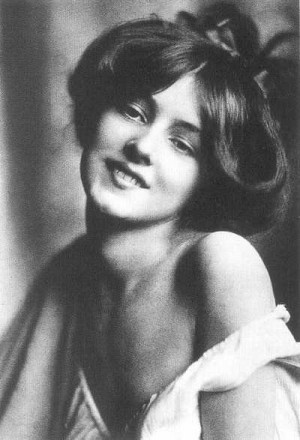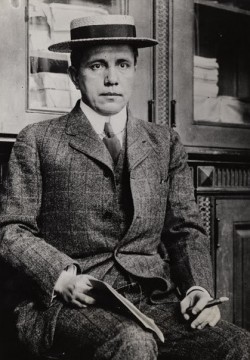The Architect, The "It" Girl And The Toy Pistol That Wasn't
The Architect, The “It” Girl And The Toy Pistol That Wasn’t
by Evan Hughes

One warm June night in 1906, Albert Payson Terhune could be found engaged in battle for a telephone booth in the old Madison Square Garden while wearing a tuxedo. He had forcibly removed a man mid-conversation, and now, as he shouted into the phone, he kicked out a leg and swung his free arm to fend off the displaced caller and another man wielding a chair. Moments before and one floor above, Terhune, filling in as a drama critic for the New York Evening World, had been a witness to the crime of the century, and he was calling in the scoop.
The movie version of his half of the conversation would go something like this: “Right, yes, that Stanford White. It’s about Evelyn Nesbit!”
Stanford White, a driven and charismatic man, was a founding partner of McKim, Mead and White, a firm responsible for an absurdly large portion of New York’s grandest architecture. Their legacy includes Columbia University’s main campus, the James Farley Post Office, the Brooklyn Museum, the Morgan Library, all still standing, and most famously the original Penn Station (whose demolition in 1963 is mourned by everyone in the world except two people).
Evelyn Nesbit had arrived in New York as a teenager with her debt-laden mother and acquired some notice as a model and a chorus girl. A familiar path, but in her case both the initial innocence and the heat of the spotlight were particularly pronounced. As she moved from artist’s studio to men’s-club stage and postcards of her face cropped up around the city, she relied heavily on her mother to supervise her career and social life. Her mother appears to have been clueless about both.
According to Paula Uruburu’s overheated but dishy and informative American Eve, Nesbit’s fusion of naïveté and sex appeal made her “the ur-Lolita. The very first ‘It’ girl, before anyone knew what ‘It’ was.” In photographs she looks like a cross between a younger Madeleine Stowe and Olivia Hussey, co-star of the Franco Zeffirelli film of Romeo and Juliet. These are not the kind of century-old photos that make you puzzle over changing standards of beauty.

In White’s circles, which included Rockefellers, Morgans, Henry James and Edith Wharton, only some knew that the married White was a philanderer with a weakness for young ladies. In 1901 he arranged to meet Nesbit after seeing her perform. At first the architect, 46 to Nesbit’s 16, treated her as only a “protégée,” showing her which one was the salad fork, as it were, and having her discolored tooth fixed as if she were a flawed doll. His status and generosity kept her mother happy despite the warning signs.
One evening “Stanny” gave Evelyn a thorough tour of his married man’s bachelor pad, occupying several floors in a row house on sketchy West 24th Street, in “the Tenderloin.” One room had mirrors on every wall. Another had a four-poster bed with mirrors in the headboard and the canopy, and yet another room held the red velvet swing that later became infamous. (On the ground floor was the FAO Schwarz toy store, which fact would not be credible in fiction.)
White poured her an unusual quantity of champagne that night, which she later said tasted funny, and the lurid story ends with her waking up sore and mostly undressed, with a naked White next to her. Details of her account varied between her two memoirs, but the gist was the gist, terrible no matter what.
Traumatized but feeling confused and powerless, Nesbit would remain White’s lover for months. On her visits to the row house, White delighted in giving her a push as she rode the velvet swing in a state of undress. She would later offer the reminder, in explanation, that she was 16 and liked riding swings.
When Nesbit caught on to White’s roving eye with other young things, she too moved on, with the gaze of the penny press upon her. First she became involved with John Barrymore, then a 21-year-old illustrator, and the two had the kind of mutual infatuation befitting their age, promenading through Central Park and seeking each other out day after day. White and Evelyn’s mother interfered, however, and the relationship came to an end. Soon she met Harry K. Thaw, an impulsive, juvenile man in his thirties who felt the need to prove himself to “society” though he was the heir to a $40 million coal and railroad fortune.

In the era of Comstock’s New York Society for the Suppression of Vice, Thaw posed himself as a crusader for moral purity. Owing to rumors about White’s private life, Thaw had it in for him even before knowing the details involving Nesbit.
Meanwhile, in private, Thaw cultivated a habit of whipping young boys and women. When Nesbit reluctantly told him about her past with Stanford White, he beat her with a leather riding crop in return for her honesty. Thaw became more and more controlling and obsessed, even deranged, over her relationship with White, pressing her for every detail.
White reasserted himself when he heard of Thaw’s behavior, and a clash of big-money foes ensued. Each gathered potentially ruinous evidence about the other, paying detectives and informants to get it, while Nesbit ducked beneath the crossfire. Finally, following a relentless campaign of proposals, she agreed to marry Thaw, and White had to stand down. Thaw was protective of Nesbit, to the point of hired surveillance, and made her promise to tell him if she ever came across White.
That June evening in 1906, Thaw escorted his wife to Madison Square Garden for a fancy premiere attended by some 900 people. She was unpleasantly taken aback by the surprise destination for this date. As Thaw of course knew, White had personally designed the Garden and kept an elegant studio apartment in the building, up in the magnificent tower topped by a statue of the goddess Diana. Evelyn nervously scanned the crowd for her former lover.
Built in 1891, this version of the Garden, to its credit, bore no resemblance to the current one — it wasn’t even located in the same place — and it was probably White’s highest achievement. The arena overlooked Madison Square Park, and one feature of its elegance was that on its roof was a huge outdoor restaurant, complete with the stage that hosted that night’s performance of Mamzelle Champagne. The black-tie audience dined beneath the stars, surrounded by huge potted plants and lanterns and elaborate decorations.
White was nowhere to be found for the opening of the musical, to Nesbit’s relief, but suddenly he strode in toward the end, at nearly 11 p.m., acknowledging those in the crowd who recognized him, and sat by himself in the fifth row. Thaw did not see White at first but seemed agitated, and when he stood up, Nesbit suggested in a strained voice that they leave. He agreed, but as they entered the elevator Thaw slipped out and disappeared.
The crowd near White saw a man walk right up to him and raise what appeared to be a toy pistol. Then, in the parlance of the day, dude shot him in the face. Thaw fired three times with a very real gun. White was clearly beyond saving. But many who had a poor view thought it was a stunt, all part of the show, and yelled to the performers that they ought to continue. Some of them carried on pathetically with the music and dance, clearly confused, while a few chorus girls, not confused, fainted to the floor.

Witnesses heard Thaw say, “I shot him because he ruined my wife.” (The last word might have been “life,” but “wife” lends itself better to the appropriate level of melodrama.) While Nesbit cried out nearby, Thaw calmly surrendered to a policeman, who declined to cuff him since he was obviously a gentleman.
The high society murder, with whispers of a lurid backstory, drove the press and the public into a true frenzy, with every shred of speculation and embellishment deemed worthy of a report. Thomas Edison’s studio turned out a film version of the Rooftop Murder only a week after the crime, Uruburu writes, and it hit number one at the box office. The trial, when it finally arrived, was the first in American history in which the jury had to be sequestered, and some 600 potential jurors were interviewed to settle on 12 uncorrupted souls.
The only strategy for Thaw was to plead insanity, but the Thaw family wanted to stress that it was a “temporary brainstorm” rather than a possibly hereditary madness. The prosecution — and again, this is not a novel — described a new condition, “Dementia Americana,” that could cause an American male to be driven to kill by the violation of the sacredness of his wife. Thaw himself wanted to cry out that he was perfectly sane and simply avenging an angel’s “ruination” at the hands of a demon.
Nesbit, who now had only the Thaws to support her and had a notoriety that left no prospect of a next marriage, took the stand and told the world, in a steady voice, the story of Stanford White and Harry Thaw. President Roosevelt sought to suppress the transcript of the trial, for fear of further damage to American morality and productivity. No luck. The papers seized on the mirrored bedroom, the red velvet swing and the depravity of two wealthy men.
The result was a hung jury, followed by another circus of a trial that resulted in a verdict of insanity. Thaw’s incarceration at a home for the clinically insane in Fishkill, New York, was as cushy as wealth could afford, Uruburu writes. Nesbit stood by him and visited him regularly, but she despaired of his bizarre and unremorseful behavior, and eventually departed for Europe.
The tabloids followed her everywhere. Her life became a tawdry parade of exploitation and scandal and even attempts at suicide, but it lasted all the way to 1967. She never turned against the great architect completely, refusing to demonize him and speaking of his “only vice.” But the world certainly turned against her. In her last memoir she wrote, “The tragedy wasn’t that Stanford White died, but that I lived.”
Previously: Larry David’s Rough Night Out With The Aging Literary Lion and The Cordial Enmity Of Joan Didion And Pauline Kael
Evan Hughes’ book, Literary Brooklyn, a work of literary biography and urban history, has just been published. He’s on twitter.
